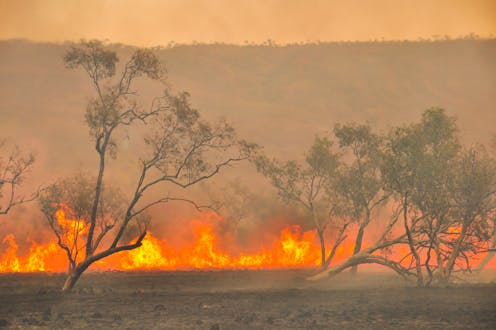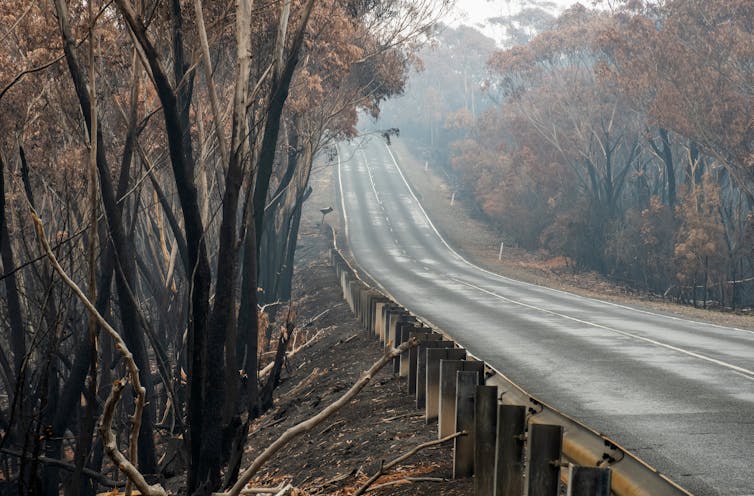
Last year, campers had to evacuate because of floods. This year, they’re evacuating because of fire. Over Victoria’s long weekend, campers and residents in Gippsland had to flee fast-moving fires, driven by high winds.
The megafires of the 2019–2020 Black Summer came off the back of an earlier El Niño climate cycle. Now, after three years of rain and floods, El Niño is arriving on Australian shores again. With it comes fire weather – hot, dry and windy.
The question is – are we ready?
Last week, emergency management minister Murray Watt moved to reassure an anxious country. “Australia is much better prepared for this season than we were heading into Black Summer,” he said, speaking after a national summit on disaster preparedness.
Yes, authorities are better prepared. But by and large, we as individuals are not. Far too often, Australians think it’s the job of the authorities to be ready, which breeds a false sense of security.
This fire season may pack a punch
The Black Summer bushfires of the 2019–20 summer were a stark reminder of how fire prone Australia is. But they were more than that – they were not normal. Around 20% of all of our forests went up in flame.
2019 was the hottest and driest year on record for Australia. But 2023 may break that record, as climate records topple around the world and extreme weather events multiply. This year is likely to be the hottest on record globally, and next year the record may well fall again.
Sustained rain from three successive La Niña years has driven widespread vegetation growth across Australia’s 125 million hectares of forest, bush and grasslands. Over the coming weeks, many areas could dry out quickly and become tinder for bushfires.
Read more: Worried about heat and fire this summer? Here's how to prepare
Climate cycles do give us time to prepare
Australia’s wet-dry climate cycles have one benefit – during wet years, fire authorities get a reprieve. That lets governments, emergency services and the community coordinate, plan and prepare for bushfire seasons ahead.
That’s why Minister Watt can accurately claim Australia is better prepared. The capacity and capability of our emergency services to predict the spread of fires and issue timely warnings to communities is better than it has ever been. In planning and preparedness for natural hazards such as bushfires and floods, we have seen better integration between government, emergency services, civil and private sector organisations.
Planned burning is still a challenge. It’s tough to find the right weather conditions to burn off fuel loads at low intensity, without risking the blaze spreading or threatening property.
But these burns are done much more strategically these days. Rather than simply aim to hit a target of hectares burned, authorities are now focused on burning fuel in areas where it could endanger lives and damage critical infrastructure during bushfire season.
These advances give us good reason for confidence. But not for complacency.
Every bushfire is unique. And our fires are, by and large, getting worse. It would be an error to think our investment in smoke-detecting algorithms and satellite monitoring and the development of the new Australian Fire Danger Rating System will spare Australia from the loss of life, property and environmental destruction observed during the Black Summer fires.
Why? Decades of bushfires have shown even the best preparation can be found wanting on days of severe bushfire danger when firestorms can develop quickly and behave unpredictably.
For Australia to be ready, you need to be ready
While megafires happen – and draw the most headlines – most bushfires are local rather than national events.
That means we must prepare at a local level.
If you’re faced with a bushfire threat, you have only two options.
You can stay and defend your property – as long as you are physically and mentally prepared, have adequate firefighting resources, and your property is prepared and defensible.
Read more: Fire regimes around Australia shifted abruptly 20 years ago – and falling humidity is why
Or you can leave early, which means making a judgement call about the best time to go in a calm manner. That doesn’t mean panic – if there is time, it can be possible to do things like clear fuels from around the home and dampen the surrounds to give your house a better chance of surviving undefended.
Which should you choose? It depends, in part, on where you live and your personal circumstances. Remember too that most Australians will never experience a bushfire firsthand.
Every community has a different risk profile and people and communities vary considerably in their levels of preparedness and planning.
If a fire does start and head towards your house, you could be taken entirely by surprise if you have no bushfire plan.
To be clear, this is arguably the largest gap in Australia’s fire preparedness.

Planning is easy – if done ahead
The question of whether Australia is ready for the fire season should be reframed. The better question is: are Australians ready?
The good news is, it’s easier than you think to make a fire plan. As a household, it might take just 10 minutes. Your state or territory government has a website showing you how:
- Victoria
- New South Wales
- Queensland
- South Australia
- Western Australia
- Australian Capital Territory
- Northern Territory
- Tasmania
Why plan ahead? Because it is vastly better to have a clear plan at your fingertips rather than frantically trying to figure out where your loved ones are, whether it’s too late to leave and whether you could realistically fight the fire – when the fire is on your doorstep. Faced by the reality of fire, many of us can freeze.
What firefighters want us to learn is that the critical decisions and actions which save lives and property in a bushfire are taken by us and our communities, not by politicians or agencies.
Read more: Australia's Black Summer of fire was not normal – and we can prove it
John Schauble contributed significantly to this article. He has worked extensively in bushfire policy and research at state level and has volunteered for over 40 years as a firefighter.
Graham Dwyer receives funding from Natural Hazards Research Australia and the Australian Research Council.
This article was originally published on The Conversation. Read the original article.







